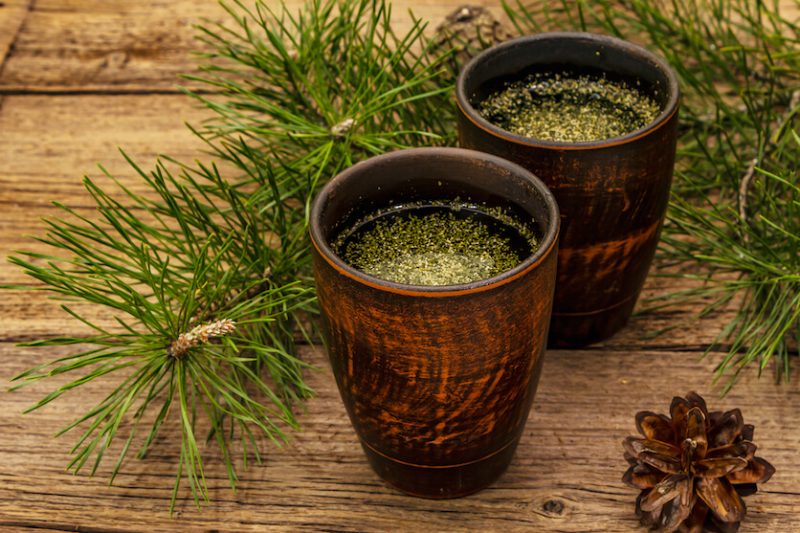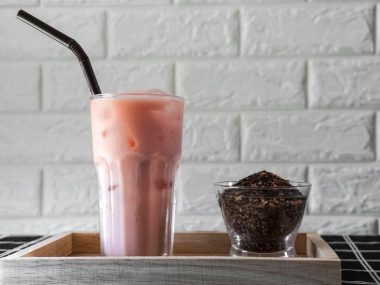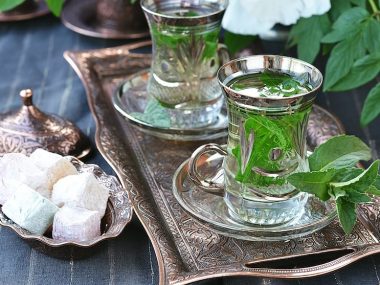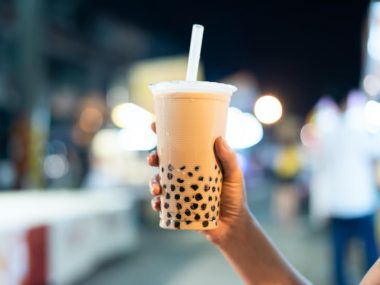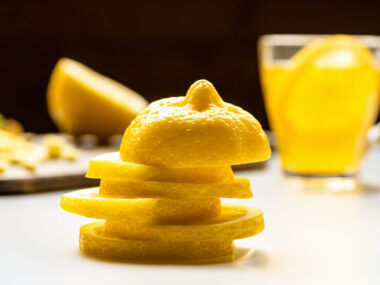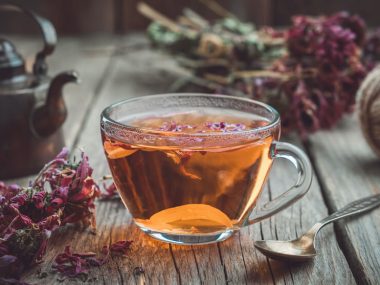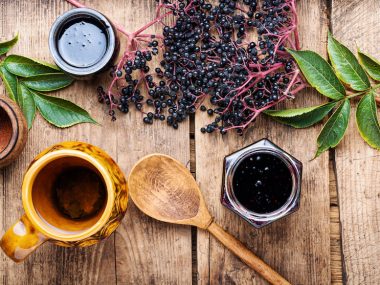Most of us have never considered pine needle tea. Yet, many people online swear by its therapeutic properties. But before going out to pick your own pine needles for a tea, you’ll want to read our guide first. After all, not all pine needle trees are safe for consumption.
Table of Contents
What Is Pine Needle Tea?
Pine needle tea is a tea brewed from the needles (leaves) harvested from a pine tree. Depending on what country you live in, pine needle tea can be made from one of numerous pine species. Here in the U.S., pine needle tea is made from white pine (Pinus strobus.) Korea makes pine needle tea from the Japanese Red Pine (Pinus densiflora.)
White pine is native to the northeast region of the U.S., southeastern Canada, and parts of Nova Scotia. Native Americans have relied on this tea for hundreds of years to treat various ailments. It is also popular among the traditional, folk, and Chinese medicine communities.
What Are Pine Needles?
Pine needles are pointed, needle-like leaves that grow on a tree of the same name. Pine trees belong to the Conifer family, which also includes spruce and fir. Many people often refer to spruce and fir as pines. However, these trees are separate species. Pine needle tea is made from the needles off of a pine tree, not a spruce or fir.
Pine Needle Uses
Pine needles are used to make tea but also to make wines, herbal supplements, and food products (pine nuts). The use of pine goes beyond the needles.
Lumber is harvested from pine trees to make furniture, cabinets, and wood for construction. The paper industry uses pine wood to make paper. Pine resin is the sticky, oozing substance (not the sap) used in traditional medicine, folk medicine, and Chinese medicine as a salve, ointments, tincture, and more.
White pine had historical value. During the 1700s, the Royal Navy harvested large swaths of these trees here in the U.S. to make masts, furniture, construction, and more. This tree species was held in such high regard that it found its way on an ornamental coin issued by the New England Mint.
Which Pine Needles Are Safe For Tea?
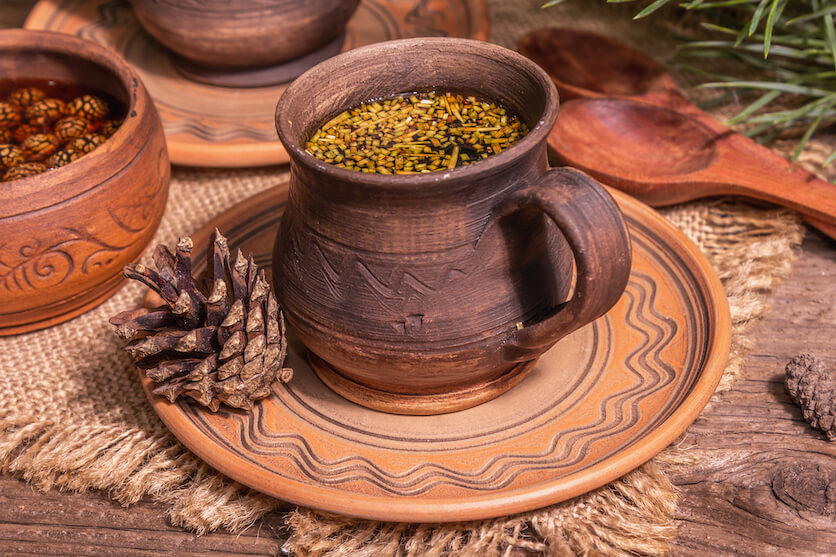
When gathering pine needles to make tea, it’s important that you be familiar with distinguishing needles of a pine, spruce, and fir. This prevents you from harvesting needles from the wrong species of tree.
Identifying Conifer Needles
If you are in the U.S. and looking to harvest your own pine needles for tea, you’ll want to find a white pine. For those in other countries, we suggest doing your homework on what native species grow in your region and if they are safe or unsafe to make tea from.
Spruce Needles
- Sharp
- Pointy
- Square
- Rigid
- It easily rolls between fingers
- Attached to woody stalks protruding from the branch
Fir Needles
- Flat
- Soft
- Difficult to roll between fingers
- Attached to branch
Pine Needles (such as white pine)
- Clusters of two, three, or five attached together
- Longer than fir or spruce needles
Toxic Conifers
We scoured resources trying to find a precise listing of poisonous/toxic conifers. Unfortunately, such a list does not exist. We managed to find a few sources that mentioned specific species as toxic.
Yew (Taxus)
The Conifer Society mentions that all species of Yew have taxanes which is a very poisonous alkaloid. It is best to pass on attempting to make tea with any part of a Yew.
Ponderosa Pine (Pinus ponderosa)
The National Library of Medicine published an article (“The toxic and abortifacient effects of ponderosa pine”) noting the needles of a Ponderosa Pine can cause abortive activity in cattle when consumed. Isocupressic acid is the constituent in Ponderosa Pine needles that cause abortion. Although this has been documented in cattle, continued research is required on how it would affect humans. Because of the uncertainty, it may be best to pass on making tea with the needles of a Ponderosa Pine.
Others To Avoid
A published research study (“Hazard identification, diagnostic investigations, and risk communication on the subject of pine needle abortion”) lists additional conifer species as having potential abortive abilities in not only cattle, but bison, guinea pigs, sheep, rodents, goats, elk, and rabbit. The needles of the studied conifers were found to also contain isocupressic acid (abortifacient compound.)
In addition to Ponderosa Pine:
- Monterey cypress (Cupressus macrocarpa)
- Common juniper (Juniperus communis)
- Western juniper (Juniperus occidentalis)
- Utah juniper (Juniperus osteosperma)
- Lodgepole pine (Pinus contorta)
- Cuban pine (Pinus cubensis)
- Jeffrey pine (Pinus jeffreyi)
- Korean pine (Pinus koraiensis)
- Rocky Mountain pine (Pinus scopulorum)
- Monterey pine (Pinus radiata)
Furthermore, another research article (“Toxic Plants: Pine Needle Abortion, Ponderosa Pine, and Related Species”) lists many more (far too many to list) conifer species listed as having isocupressic acid (abortifacient compound.)
Can You Use Dried Pine Needles For Tea?
Dried pine needles of white pine are used to make pine needle tea. An interesting research study (“Shikimic acid: review of its analytical, isolation, and purification techniques from plant and microbial sources”) sheds some very interesting data on the differences of dried pine needles vs. freshly harvested.
The article lists a few pine trees (Pinus sylvestris, Pinus thunbergii) that have a powerful constituent (shikimic acid.) Shikimic acid is the precursor material used in making Tamiflu (a drug used for the influenza virus.)
Dried pine needles of Pinus sylvestris (Scotch Pine) retain about 2% of shikimic acid compared to their fresh counterpart. Fresh Scotch Pine needles had 70% shikimic acid content. This finding reveals drying pine needles causes a significant loss of shikimic acid.
What Does Pine Needle Tea Taste Like?
Pine needle tea has a distinct citrus flavor. The more resinous the pine tree species, the more the tea tends to taste similar to floor cleaner. When harvesting pine needles (providing they are from a safe pine tree), you can get an idea of how the tea will taste by taking a few needles and nibbling on them.
How Much Caffeine Is In Pine Needle Tea?
Pine needle tea is a tisane (herbal tea). Tisanes are caffeine-free because they are not made from the tea plant (Camellia sinensis). True teas (black, green, oolong, yellow, white) are caffeinated. Should a true tea be blended with pine needles, there may be up to 70 mg of caffeine in a six-ounce cup.
Is Pine Needle Tea Good For You?
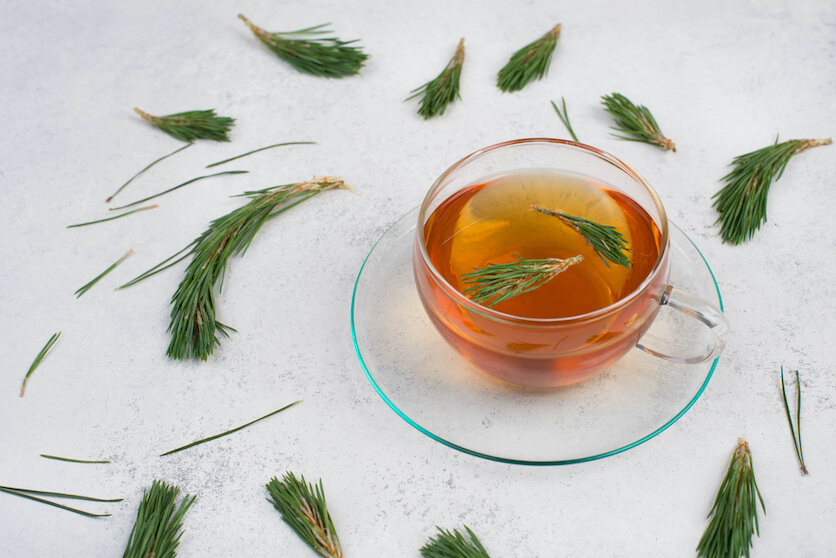
We do not have the medical expertise to provide advice or recommendations on whether or not pine needle tea is good for you. What we can do is provide you with evidence-based data that helps you to make a well-informed decision to consume it or not.
Is It Okay To Drink Pine Needle Tea Every Day?
The only way to find out if pine needle tea is safe for you to drink daily is to consult with your healthcare provider. Some tisanes (herbal tea) may cause side effects, adverse reactions, interact with medications, radiation, or chemotherapy or worsen existing medical conditions.
Because numerous conifer species may potentially be toxic or dangerous, we highly recommend talking to your doctor. Pine needle tea dangers are something you want to take seriously, especially if you have any of the following.
- Medical conditions
- Pregnant or nursing
- Under the age of 12 years
- On any medications
- Have allergies
- Undergoing radiation or chemotherapy
Pine Needle Tea Benefits
Pine needles are reported to be antioxidants according to a published research article entitled, “Anti-Inflammatory Principles from the Needles of Pinus taiwanensis Hayata and In Silico Studies of Their Potential Anti-Aging Effects.” The article goes on to mention the potential vasorelaxant ability of Pinus morrisonicola (Taiwan White Pine.)
Another research article (“Antioxidant Potential of Pine Needles: A Systematic Study on the Essential Oils and Extracts of 46 Species of the Genus Pinus”) notes that some of the benefits of pine needle tea are derived from numerous phenols (procyanidins, flavonoids, phenolic acids.) Pine needles have antioxidative bioactivity and help to reduce inflammation.
There are claims of pine needle tea vitamin C being high; however, we could not find any evidence-based data supporting these claims.
How To Make Pine Needle Tea
Now the question arises, “Where do we find a white pine tree to harvest pine tree needles?” The answer depends on your ability to correctly identify and find a white pine tree. If in doubt, you may be able to purchase some from an ethical, reputable source. It’s relatively straightforward in making pine needle tea.
Ingredients:
- 1 tablespoon white pine needles (thoroughly washed and rinsed)
- 2 cups of water
Directions:
- Bring 2 cups of water to a boil.
- Remove from the heat.
- Place the pine needles into the hot water.
- Cover and allow it to steep for 15 minutes.
- Remove the cover.
- Strain the tea into a teacup and enjoy.
“Pining” For Pine Needle Tea Or Not?
We recommend that you do your homework and talk to your doctor before enjoying this tea. We have provided you with ample background information on what you can expect in a pine needle tea. Whether you decide to consume it or not comes down to a personal choice.
